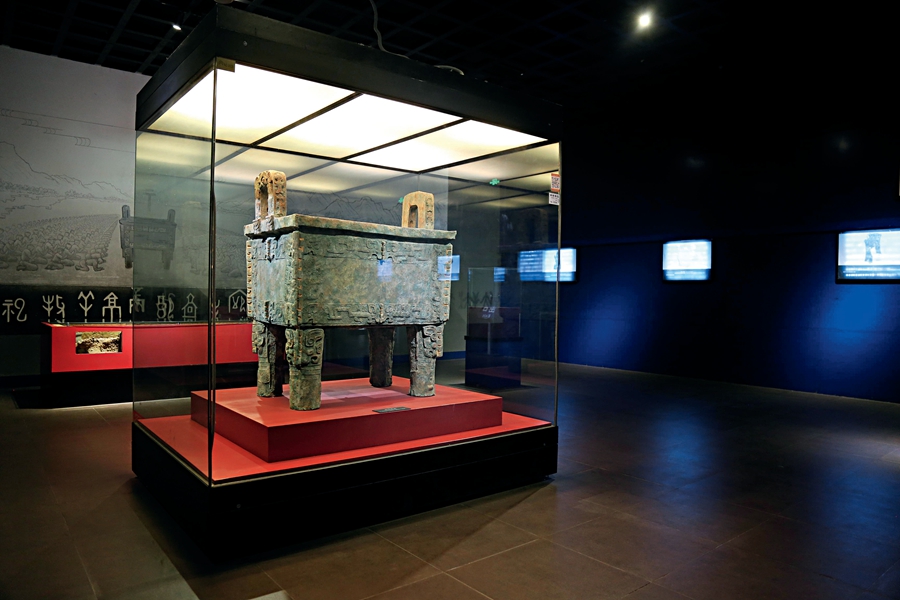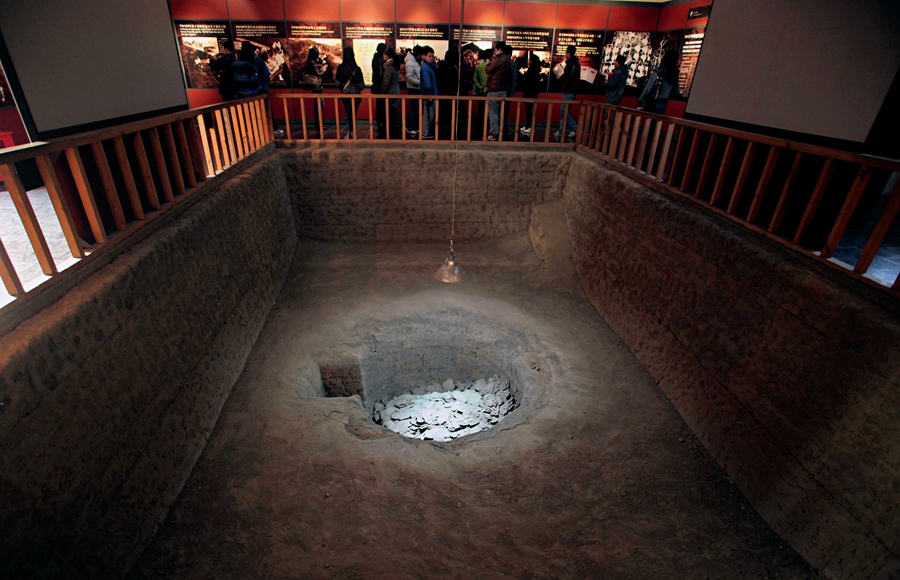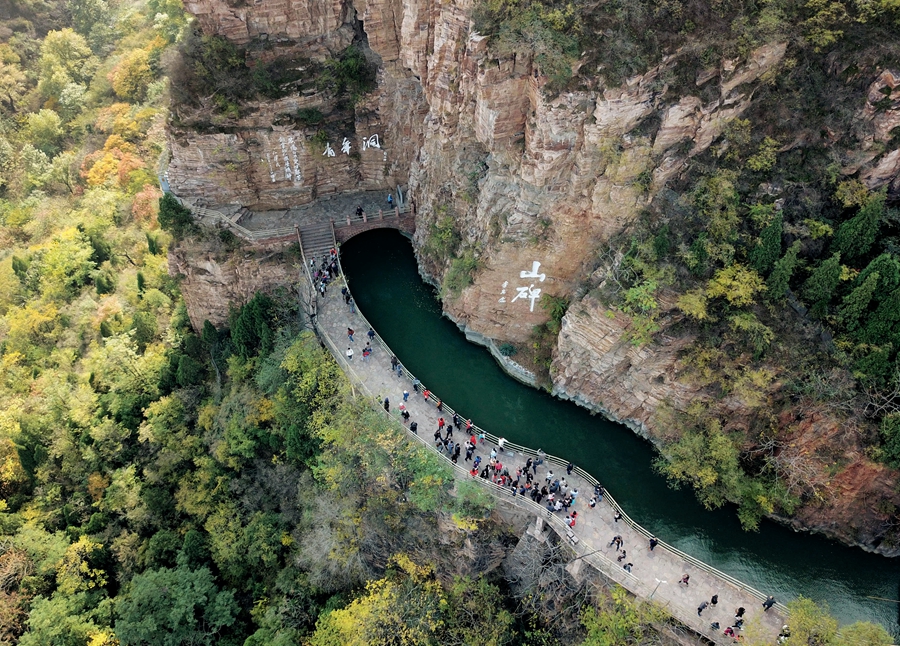China's Earliest Capital
 0 Comment(s)
0 Comment(s) Print
Print E-mail China Today, March 14, 2018
E-mail China Today, March 14, 2018
Jian'an Style Literature
Jian'an refers to the 196-220 period during the rule of Emperor Xiandi (181-234) in the Eastern Han Dynasty (25-220). At that time, China's territory was divided into different fiefs and separate regimes were in fact set up, making the central imperial rule a figurehead. The emperor had no real power. Everything was in fact controlled by Cao Cao (155-220), then prime minister of the Eastern Han. The Jian'an period saw the emergence of many refined scholars and tales of heroic deeds. Romance of the Three Kingdoms, a famous historical novel in China, is one of the stories during the turbulent years of that period.

Yecheng City was an ancient Chinese city, located in what is now Linzhang County of Hebei Province and neighboring Anyang of Henan Province. This was Cao Cao's fiefdom. Cao's rulership created a stable political environment there. He was quite fond of literature and recruited many writers and scholars, forming a large group of literati represented by Cao Cao and his sons, as well as "Seven Scholars of Jian'an." Those scholars traveled with the army during war times. During the peaceful period, they created a large number of literary works, especially poems, reflecting the unrest at the end of the Han Dynasty and people's sufferings during wars, as well as the literati's aspiration to work hard and get ahead with their careers. The Jian'an style poetry has set an example for literati of future generations for its vivid depiction of political ambitions and how much the people suffered during warring period, conveying a grievous tone. Cao Cao, who played a leading role in this group, initiated the Yuefu form of poetry (Chinese poems composed in a folk song style), exerting a far-reaching influence on not only the writers and poets of his time, but also future generations of literati.
Among all the literati, Cao Zhi (192-232), one of Cao Cao's sons, made the greatest accomplishment. His works featured florid rhetoric and heart-stirring tones, with his signature work Ode to the Goddess of the Luo River becoming a masterpiece known throughout the ages. Xie Lingyun (385-433), a famous poet of the Southern and Northern Dynasties (420-589), later praised it with the metaphor, "Cao Zhi had eight dous of a total 10 dous of the world's talent." (Dou was the ancient Chinese measure unit for grain). Since that time, the expression "eight dous of talent" has referred to a person who is very gifted.
Red Flag Canal
In Linzhou City, 70 kilometers from Anyang, there is a canal dug on steep crags, which was known by almost every Chinese in the 1970s. The canal was carved into the Taihang Mountains, and is divided like vessels that extend 1,500 kilometers in total to divert water to drought-ridden Linzhou. The canal is a testament to how humans strive to utilize natural resources.

In May 1974, Deng Xiaoping, then vice-premier of China, participated in the 6th Special Session of the UN General Assembly in New York, where he shared 10 documentaries and films that reflected the ongoing construction and changing life of people since the People's Republic of China was founded in 1949. One of them was about the Red Flag Canal, which impressed the world with the Chinese people's hard work to harness nature.
Linzhou is under the administration of Anyang City. Due to geographical conditions, the place often suffered from flood or drought. The lack of water was their biggest headache. In 1959, the local government decided to create a guaranteed water supply. They knew the Zhuozhang River had stable amount of water even during the dry season. However, the only way to divert the water was to build a long canal from the back of the Taihang Mountains.

The first crux in building the canal came from today's Youth Tunnel (Qingnian Dong), where lies the gorge part of the Red Flag Canal project. In the very beginning, the engineers wanted to build a canal along the cliff, but it turned out to be too difficult, so they decided to open up a tunnel through the mountain to let the water go through the cliff. However, the site featured quartzite, a very hard rock. Records indicate that it took more than one year for 300 young workers to drill out this 600-meter-long tunnel; therefore, it was named the Youth Tunnel.
The building of the Red Flag Canal was a very difficult project, taking a total of 10 years to complete. The builders cut through more than 1,200 hills, excavated over 200 tunnels, and built 150-odd channels and ditches. The construction took place in a very difficult period through the harshest three years (1959-1961) of the country when natural disasters swept most parts of it. Without the help of modern machines and with limited funds, 37,000 builders, each allocated with 300 grams of grain per day, completed this huge project in only 10 years with their hands and simple tools such as hoes, shovels, and baskets, creating a modern day miracle.
The Red Flag Canal channels water from Zhuozhang River to towns and villages of Linzhou City, supplying water to 670,000 people and their farm animals and irrigating over 33,500 hectares of land. Forty years on, the ground water level and soil texture has seen tremendous changes in Linzhou. Thanks to the sufficient water supply, Linzhou has tree farms, fishponds, and orchards. Standing on top of a hill in the outskirt of Linzhou City, one can see green-clad mountains and crop fields. Anyone who doesn't know about the history of the Red Flag Canal would mistakenly believe that everything in Linzhou is natural.
When the weather is pleasant, many people like to walk along the Red Flag Canal from its head in Pingshun County of Shanxi Province. It is the most direct way to see and feel the imposing project and the hardship its construction involved. Along the major channel that stretches over 70-kilometers, visitors can feel the great devotion the builders made when they pass by every cliff and tunnel.





